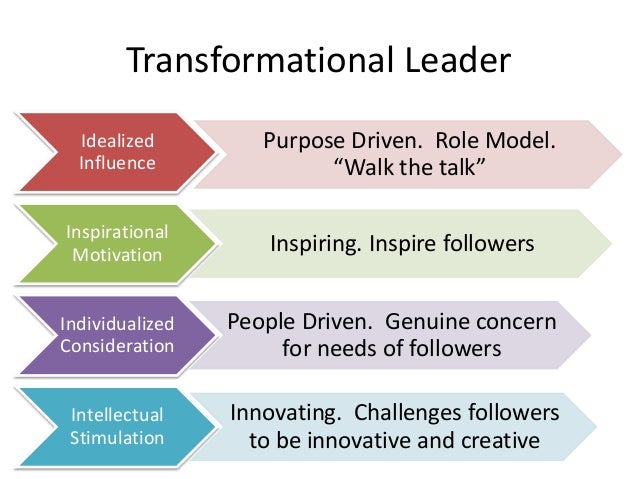So What:
When thinking of previous lessons and class material, I couldn't help but look to the idea of transformational leadership that is discussed in detail in the text Leadership Theory and Practice by Peter Northouse. He discusses four types of transformational leadership: idealized influence, inspirational motivation, intellectual stimulation, and individualized consideration. Below is a breakdown of the four types of transformational leaders presented in a SlideShare about transformational leadership.

In this breakdown, we can easily see the types of leaders and their characteristics. So, how can we relate this type of leadership to job satisfaction? The World Applied Sciences Journal released a study that researched the relationship between transformational leadership style and job satisfaction. That study can be found here. The results of the study found a positive relationship between leadership style and job satisfaction, with the strongest being from intellectual stimulation.
In addition to providing intellectual stimulation, managers will be challenged with identifying what motivates and inspires their staff to perform at their personal best. Transformational leaders prioritize these factors, which is why increased job satisfaction is proven under their leadership.
Now What:
Having learned the potential impact of transformational leadership on job satisfaction, I want to implement this leadership style in my current and future workplaces. To combat a workforce that experiences low job satisfaction, transformational leadership can be implemented in hopes to boost morale and overall job satisfaction. Employees want a leader who inspires them, has concern for their well-being, and allows individuals to be creative and innovative. Having a strong leader who possesses transformational leadership characteristics is a good place to start when wanting to improve job satisfaction of employees. People, regardless of age, will give their best if they feel appreciated for their contributions to their company. As Generation X (baby boomer) reaches the age of retirement and phase out of the workplace, managers will need to reassess their practices for engaging the predominantly Generation Y (millennial) workforce.The difference between an effective manager and ineffective manager in the areas of moral and inspiration can make or break a company's retention when it comes to employee satisfaction and company loyalty.
mmorpg
ReplyDeleteinstagram takipçi satın al
tiktok jeton hilesi
Tiktok jeton hilesi
saç ekimi antalya
TAKİPCİ SATİN AL
İnstagram Takipçi Satın Al
metin2 pvp serverlar
Takipçi satın al
YENİ PERDE MODELLERİ
ReplyDeletesms onay
Mobil odeme bozdurma
nft nasıl alınır
Ankara evden eve nakliyat
trafik sigortası
dedektör
web sitesi kurma
aşk romanları
ataşehir lg klima servisi
ReplyDeleteçekmeköy daikin klima servisi
maltepe beko klima servisi
kadıköy beko klima servisi
kartal lg klima servisi
ümraniye lg klima servisi
kartal alarko carrier klima servisi
ümraniye alarko carrier klima servisi
kartal daikin klima servisi